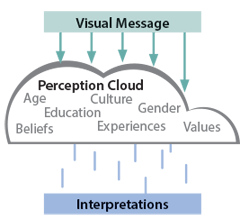Web page: How Do You Look?
Web page: Questions to ask when evaluating digital images
Web page: Analzying images
Web page: "Reading" images
The path toward visual literacy starts with active viewing. Active viewing involves understanding, interpreting, and evaluating what you see. Just as you can read and discern the meaning of a text, you can “read” and decode the meaning of a visual. The process for “reading” visual images is outlined below.
Before you can derive meaning from an image, you must understand it. Understanding involves a process of observation, inspection, description, questioning, relating, and interpreting. Each step will help you think more critically about what you are viewing.

Observe the image as a whole. Where are your eyes drawn? What is the focus of the image? How does it make you feel?
Inspect all parts of the image. Look for any symbols, body language, lighting, or other clues about the meaning.
Describe what you see by writing or speaking about it. Imagine describing the image to a friend at a party.
Question the image. Who made it? When was it made? What does it show? Where did it come from? Why was it placed here? What confuses you about it?
Relate the image to what you already know—your life experiences and prior knowledge. Also consider any surrounding text or images.
Interpret the image’s meaning. What is it meant to do, say, or show? (See page 220 for more on interpreting images.)
Your Turn Follow the first five steps explained on this page to decode the meaning of the image above. Afterward, summarize what you understand so far about the image.
When you interpret an image, you attempt to explain its meaning. Although the creator of the image (the photographer, painter, graphic artist, and so on) may intend to communicate a certain meaning to the viewer, most images are open to various interpretations.
Several factors influence the way you interpret a visual—some relate to how the image is delivered, and others are based on the personal perceptions you bring to the task (see “Perception Cloud” below). As you interpret an image, also remember to consider the elements of the communication situation (see page 68).

Our individuality, upbringing, and knowledge base filter our perception of visual messages. Your perception of an image may be different from someone else’s based on your unique traits.

Your Turn
After you interpret the meaning of a photo or image in news media, you can assess its quality, truth, and value. The questions below will help you to make an educated judgment of any image’s effectiveness.
Quality refers to an image’s visual appeal and effectiveness.
Truth measures the accuracy of an image’s communication. Today’s advanced image-editing software makes it possible to dramatically improve the quality of images, making them clearer and more visually appealing. However, those same tools can be used to distort reality or misrepresent the subject of the image.
Tip: You can critically view the photos of people featured in advertisements and magazines by looking for inconsistent lighting. Pay special attention to lighting around facial features. Inconsistent lighting is a common indicator of image alteration.
Value measures an image’s worth.
Your Turn
Web page: How Do You Look?
Web page: Questions to ask when evaluating digital images
Web page: Analzying images
Web page: "Reading" images
© 2014 Thoughtful Learning
